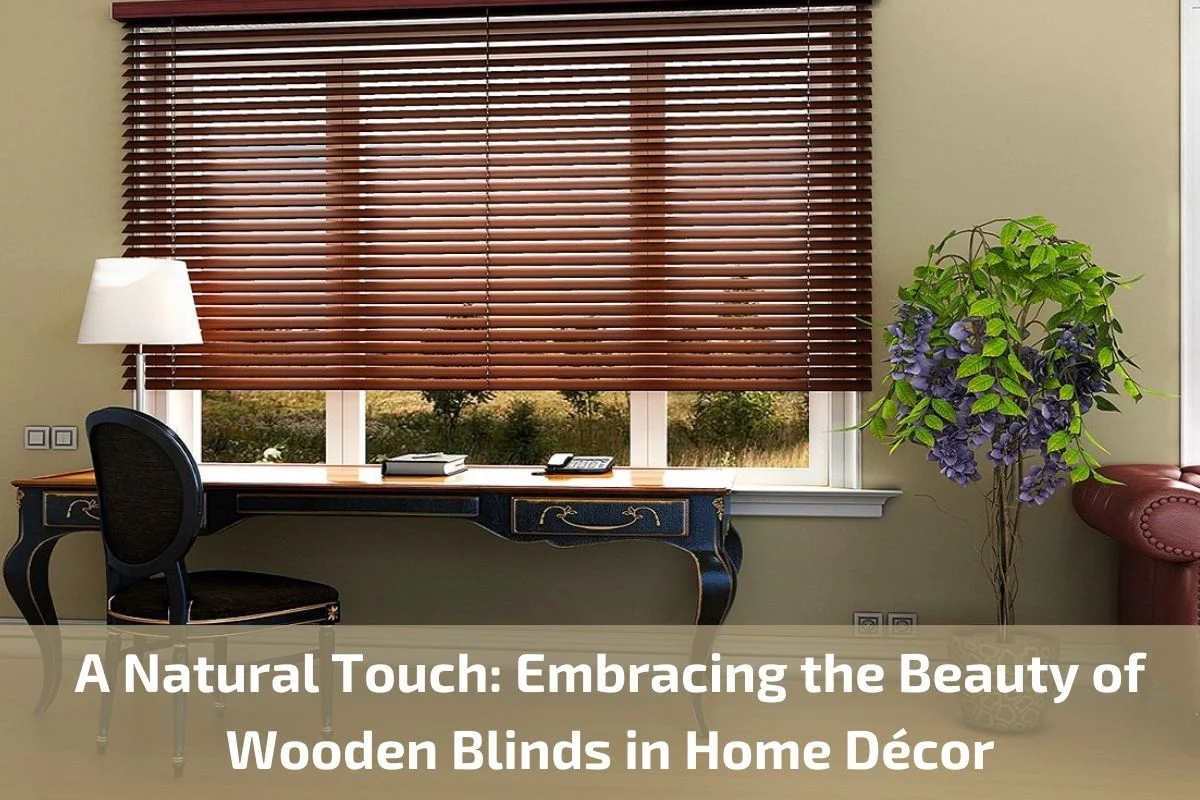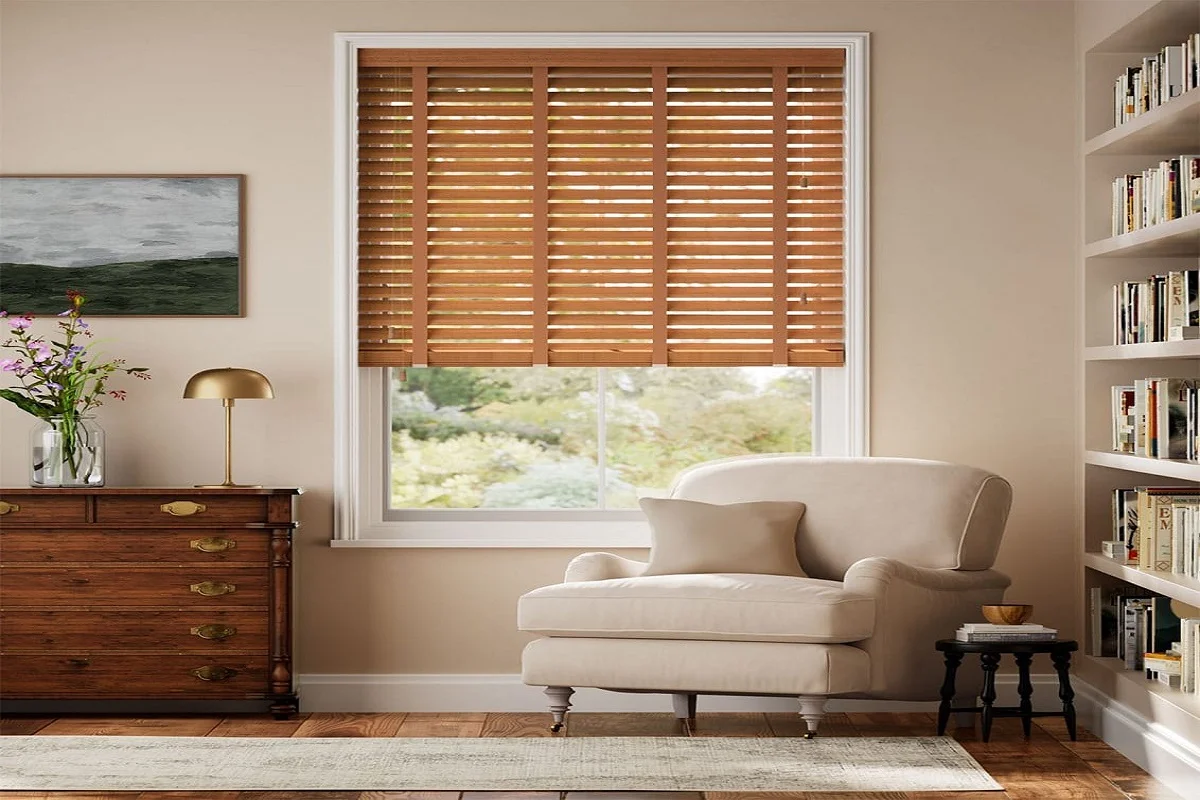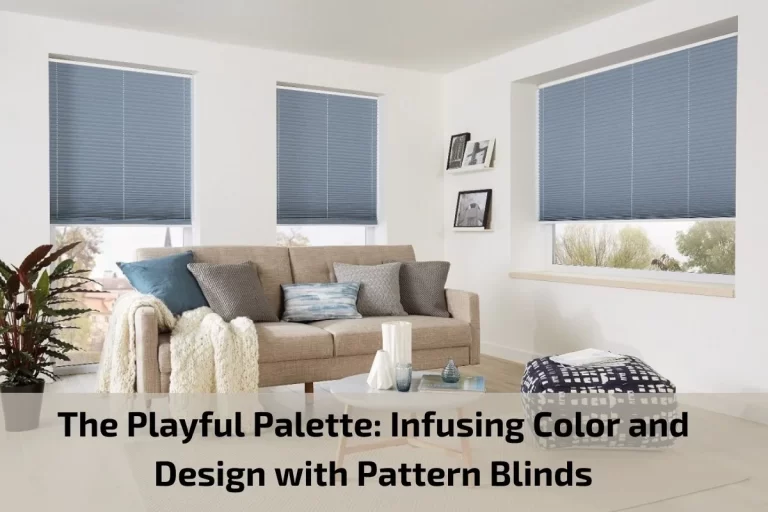In the realm of interior design, where choices abound and trends evolve, there exists a timeless element that effortlessly weaves natural beauty into the fabric of your living space—Wooden Blinds. As we navigate the myriad options available to enhance our homes, the allure of these window treatments stands out for their ability to impart a distinct warmth and character.
In this exploration of “A Natural Touch: Embracing the Beauty of Wooden Blinds in Home Décor,” we embark on a journey to discover the unique charm that wooden blinds bring to our living spaces. From their aesthetic appeal to their functional prowess, wooden blinds have long been regarded as a quintessential choice for those seeking to strike a harmonious balance between style and substance in their homes.
Importance of Wooden Blinds in home décor
Wooden blinds play a pivotal role in home décor, offering a unique blend of functionality, aesthetics, and timeless appeal. As essential components of window treatments, these versatile coverings contribute significantly to the overall atmosphere and style of a living space. Let’s delve into the importance of wooden blinds in home décor:
Aesthetic Elegance:
Wooden blinds bring a touch of natural beauty and warmth to any room. The rich textures and tones of wood create an aesthetic elegance that complements various interior design styles, from classic to contemporary. The organic feel of wooden blinds adds a layer of sophistication and visual interest, elevating the overall ambiance of a space.
Versatility in Design:
One of the key strengths of wooden blinds lies in their versatility. Available in a range of styles, including venetian, vertical, and panel track, wooden blinds can seamlessly integrate into diverse design schemes. Whether you’re aiming for a modern, minimalist look or a more traditional and cosy feel, wooden blinds provide a flexible canvas to express your unique style.
Light Control and Privacy:
Wooden blinds offer superior control over natural light and privacy. With easily adjustable slats, occupants can regulate the amount of sunlight entering a room, creating a comfortable and personalised environment. This feature is particularly valuable in bedrooms, living rooms, and home offices where privacy and light management are crucial.
Durability and Longevity:
Wooden blinds are known for their durability and longevity. When properly maintained, they can withstand the test of time, making them a wise investment for homeowners. Unlike some other window treatments, wooden blinds resist wear and tear, ensuring that they maintain their aesthetic and functional appeal for years.
Connection to Nature:
In an era where bringing elements of the outdoors inside is a popular design trend, wooden blinds serve as a direct link to nature. The use of real wood materials fosters a sense of connection with the natural world, creating a harmonious and grounding atmosphere within the home.
Energy Efficiency:
Wooden blinds can contribute to energy efficiency by acting as insulators. The natural insulating properties of wood help regulate indoor temperatures, keeping rooms cooler in the summer and warmer in the winter. This energy efficiency not only enhances comfort but can also lead to cost savings on heating and cooling expenses.
Customization Options:
Wooden blinds offer a wide range of customization options, allowing homeowners to tailor the window treatments to their specific preferences. From choosing the type of wood and finish to selecting slat sizes and decorative tapes, the ability to customise wooden blinds ensures a personalised touch that aligns perfectly with the overall design vision.
Different types of Wooden Blinds Used
Wooden blinds come in various types, each offering distinct features and aesthetic appeal. Here are some of the most common types of wooden blinds used in home décor:
Venetian Blinds:
- Overview: Venetian blinds are perhaps the most well-known type of wooden blinds. They consist of horizontal slats that can be tilted to control light and privacy.
- Materials: Venetian blinds are often made from a variety of wood types, including basswood, bamboo, or faux wood for increased durability.
Vertical Blinds:
- Overview: Vertical wooden blinds have vertically hanging slats, making them ideal for large windows or sliding doors. They offer excellent light control and can be easily adjusted.
- Materials: Vertical blinds are commonly crafted from wood, faux wood, or a combination of materials to ensure flexibility and durability.
Panel Track Blinds:
- Overview: Panel track blinds consist of large fabric panels that move along a track. Wooden versions provide a sleek and contemporary look, offering a unique alternative to traditional horizontal slats.
- Materials: The panels can be made from real wood or faux wood, providing a modern touch to window treatments.
Bamboo Blinds:
- Overview: Bamboo blinds are crafted from natural bamboo, providing a unique and eco-friendly window treatment option. They add a touch of texture and a tropical feel to the space.
- Materials: As the name suggests, these blinds are primarily made from bamboo, which is lightweight, durable, and sustainable.
Woven Wood Blinds:
- Overview: Woven wood blinds are created by weaving natural materials like bamboo, reeds, and grasses. They offer a distinct, organic look and allow filtered light to enter the room.
- Materials: These blinds feature a combination of woven materials, providing a textured and visually appealing window covering.
Honeycomb or Cellular Wood Blinds:
- Overview: Honeycomb or cellular blinds are known for their energy-efficient design, featuring pockets that trap air and provide insulation. Wooden versions combine the natural appeal of wood with the energy-saving benefits.
- Materials: The honeycomb structure can be integrated with wooden slats, offering a unique combination of style and functionality.
Faux Wood Blinds:
- Overview: Faux wood blinds mimic the appearance of real wood but are crafted from synthetic materials. They are an excellent choice for areas with high humidity or direct sunlight.
- Materials: Faux wood blinds are typically made from PVC, vinyl, or a combination of materials to achieve the desired wood-like appearance.
Motorized Wooden Blinds:
- Overview: Embracing modern technology, motorised wooden blinds allow for remote or automated control. This type offers convenience and is suitable for hard-to-reach or large windows.
- Materials: Motorised systems can be integrated with various wooden blind styles, providing a contemporary solution for smart homes.
Advantages and Disadvantages of Wooden Blinds
Advantages of Wooden Blinds:
Aesthetic Appeal:
- Pro: Wooden blinds add a timeless and elegant touch to any space. The natural beauty of wood complements various interior design styles, from classic to modern.
Versatility:
- Pro: Available in various styles (venetian, vertical, etc.) and types of wood, wooden blinds are versatile, allowing homeowners to choose the option that best suits their design preferences.
Light Control:
- Pro: Wooden blinds offer excellent control over natural light. The adjustable slats enable users to regulate the amount of sunlight entering a room, providing flexibility and enhancing comfort.
Privacy:
- Pro: With easily adjustable slats, wooden blinds offer effective privacy control. Occupants can customise the angle of the slats to maintain privacy while still allowing light into the room.
Insulation and Energy Efficiency:
- Pro: Wooden blinds, especially those with honeycomb or cellular designs, provide insulation. They can help regulate indoor temperatures, contributing to energy efficiency and potentially reducing heating and cooling costs.
Durability:
- Pro: Real wood blinds are known for their durability and longevity when properly maintained. They can withstand the test of time and resist wear and tear.
Connection to Nature:
- Pro: Wooden blinds bring a natural element into the home, fostering a connection to nature. This is particularly appealing in a design era that values the incorporation of natural materials.
Customization Options:
- Pro: Wooden blinds offer a range of customization options, including different wood types, finishes, and decorative tapes. This allows homeowners to tailor the blinds to their specific design preferences.
Disadvantages of Wooden Blinds:
Cost:
- Con: Real wood blinds can be more expensive than alternative materials. The cost of wooden blinds may be a consideration for budget-conscious homeowners.
Maintenance:
- Con: Wooden blinds may require more maintenance compared to other materials. They can be sensitive to moisture and may need regular cleaning and care to prevent warping.
Humidity Sensitivity:
- Con: Wooden blinds, especially those made from natural wood, can be sensitive to humidity. In high-humidity environments, there is a risk of warping or damage over time.
Weight:
- Con: Wooden blinds can be heavier than blinds made from alternative materials. This may affect the ease of installation and operation, especially for larger windows.
Limited Color Options:
- Con: While wood offers a variety of natural tones, the colour options for wooden blinds may be limited compared to other materials. This can be a drawback for those seeking a specific colour scheme.
Not Suitable for All Environments:
- Con: Wooden blinds may not be the best choice for high-moisture areas such as bathrooms or kitchens. In these spaces, alternative materials like faux wood or aluminium blinds might be more suitable.
Wooden Blinds into Different Décor Styles
Wooden blinds are incredibly versatile window treatments that seamlessly integrate into various décor styles, adding a touch of natural elegance and warmth to any space. Let’s explore how wooden blinds can enhance different interior design schemes:
Modern and Minimalist Décor:
- Characteristics: Clean lines, neutral colours, and a focus on simplicity.
- Wooden Blinds Integration: Opt for sleek, horizontal wooden blinds with a smooth finish. Choose a light wood tone or go for a darker shade to create a contrasting focal point. The clean and uncluttered look of wooden blinds complements the minimalist aesthetic.
Classic and Traditional Design:
- Characteristics: Timeless furniture pieces, rich colours, and ornate details.
- Wooden Blinds Integration: Select wooden blinds with intricate grain patterns and finishes that match classic wood furniture. Venetian blinds with wide slats can evoke a traditional feel, while deep, warm wood tones contribute to a sense of heritage and elegance.
Coastal or Beach-Inspired Theme:
- Characteristics: Light and breezy atmosphere, soft colour palette inspired by the ocean.
- Wooden Blinds Integration: Choose bamboo or light-coloured wooden blinds to evoke a coastal vibe. The natural texture of wooden blinds complements the relaxed and airy feel of beach-inspired décor, bringing in an element of nature.
Rustic or Farmhouse Style:
- Characteristics: Weathered wood, earthy tones, and a mix of vintage and repurposed elements.
- Wooden Blinds Integration: Embrace the rustic charm of wooden blinds with distressed finishes or reclaimed wood materials. Woven wood blinds, showcasing the raw texture of natural materials, align perfectly with the warmth and authenticity of a farmhouse aesthetic.
Contemporary and Eclectic Interiors:
- Characteristics: Diverse mix of styles, bold colour choices, and a blend of modern and traditional elements.
- Wooden Blinds Integration: In eclectic spaces, wooden blinds act as a unifying element. Opt for wooden blinds with interesting grain patterns or unique slat designs. The natural material of wooden blinds provides a neutral backdrop, allowing other eclectic elements in the room to shine.
Scandinavian Design:
- Characteristics: Light, airy spaces, neutral colours, and a focus on functionality.
- Wooden Blinds Integration: Scandinavian design embraces the use of light wood tones and natural materials. Wooden blinds in light finishes, such as beech or maple, contribute to the overall brightness of the space while maintaining a connection to nature.
Urban Industrial Setting:
- Characteristics: Exposed brick, metal accents, and a blend of modern and industrial elements.
- Wooden Blinds Integration: Choose wooden blinds with a modern edge, such as dark-stained wood or faux wood with a distressed finish. The juxtaposition of the natural wood against industrial elements creates a stylish and urban aesthetic.
Transitional Style:
- Characteristics: A balance between traditional and contemporary elements.
- Wooden Blinds Integration: Wooden blinds with a simple yet elegant design work well in transitional spaces. Choose a versatile wood tone that complements both traditional and modern furniture, helping to bridge the gap between different styles.
Conclusion
In conclusion, the enduring appeal and versatility of wooden blinds make them a remarkable addition to any home’s interior décor. As we’ve explored the various types, styles, and advantages of wooden blinds, it’s evident that these window treatments go beyond mere functionality—they become integral elements that enhance the aesthetic and ambiance of living spaces.









